

Writing a 2D HTML game: Cycletrons. At Cycle–IT we enjoy playing with whatever device, platform or language we happen to have at hand.
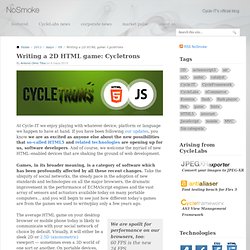
If you have been following our updates, you know we are as excited as anyone else about the new possibilities that so–called HTML5 and related technologies are opening up for us, software developers. And of course, we welcome the myriad of new HTML–enabled devices that are shaking the ground of web development. Games, in its broader meaning, is a category of software which has been profoundly affected by all these recent changes. Html5shiv - HTML5 IE enabling script. Dual licensed under the MIT or GPL Version 2 licenses Full original, uncompressed source available here: Source code adds new HTML5 elements (which is simple code), but also supports printing HTML5 elements and includes the default styles for HTML5 elements, like block on article and section.
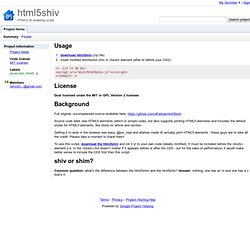
Getting it to work in the browser was easy, @jon_neal and afarkas made IE actually print HTML5 elements - these guys are to take all the credit. Please take a moment to thank them! HTML5 enabling script. 7 Jan Since HTML5 is getting more attention by way of marking up our new pages, and the only way to get IE to acknowledge the new elements, such as <article>, is to use the HTML5 shiv, I’ve quickly put together a mini script that enables all the new elements.

Download html5shiv.js and must be inserted in the head element (this is because IE needs to know about the element before it comes to render them – so it can’t sit in the footer of the page, i.e. below the elements in question). I’ve updated this post to link to Alexander Farkas’s version of the shiv – it’s the very latest and my simple one line script.
The one I originally released was (I thought) beautifully small, but didn’t support print styles nor dynamic injection of HTML5 elements. Good thing there are smarter folk than I!
HTML5. This specification defines the 5th major version, second minor revision of the core language of the World Wide Web: the Hypertext Markup Language (HTML).
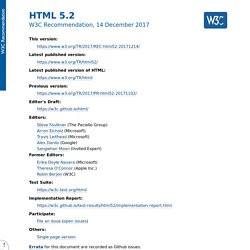
In this version, new features continue to be introduced to help Web application authors, new elements continue to be introduced based on research into prevailing authoring practices, and special attention continues to be given to defining clear conformance criteria for user agents in an effort to improve interoperability. HTML5 Reference. It is useful to make a distinction between the vocabulary of an HTML document—the elements and attributes, and their meanings—and the syntax in which it is written.
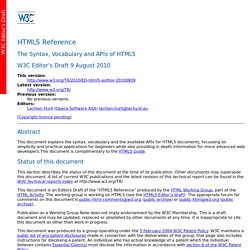
HTML has a defined set of elements and attributes which can be used in a document; each designed for a specific purpose with their own meaning. Consider this set of elements to be analogous to the list of words in a dictionary. This includes elements for headings, paragraphs, lists, tables, links, form controls and many other features. This is the vocabulary of HTML. Similarly, just as natural languages have grammatical rules for how different words can be used, HTML has rules for where and how each element and attribute can be used.
The basic structure of elements in an HTML document is a tree structure. 3.1 Syntactic Overview There are two syntaxes that can be used: the traditional HTML syntax, and the XHTML syntax. The HTML syntax is loosely based upon the older, though very widely used syntax from HTML 4.01. HTML - W3C Wiki. HTML5 Tutorial. HTML5 Tutorial - Welcome. 15 Useful HTML5 Tutorials and Cheat Sheets. 1911 shares 8 Must-have Cheat Sheets for Web Designers and Developers As a web designer or developer, it’s nearly impossible to remember multiple programming languages, frameworks, and keyboard shortcuts to various applications.
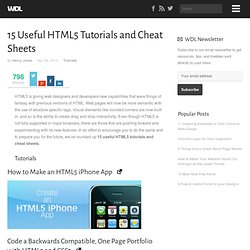
This is where cheat sheets can be a life saver. Most cheat sheets are designed to be printer friendly, so you can have them laying around on your desk as quick reference cards. So… Read More 2705 shares Photoshop CS6 Cheat Sheet Photoshop is one of the preferred tools of web designers, and like any other tool that is used over and over, it’s important to optimize one’s workflow by using keyboard shortcuts. Pro HTML5 and CSS3 Design Patterns. Pro HTML5 and CSS3 Design Patterns is a reference book and a cookbook on how to style web pages using CSS3 and HTML5.

It contains 350 ready-to-use patterns (CSS3 and HTML5 code snippets) that you can copy and paste into your code. Each pattern can be combined with other patterns to create an unlimited number of solutions, and each pattern works reliably in all major browsers without the need for browser hacks. HTML5 and CSS3. HTML5 & CSS3 for the Real World. The Definitive Guide to HTML5. eBook Details: Paperback: 1080 pagesPublisher: Apress; 1st edition (December 14, 2011)Language: EnglishISBN-10: 1430239603ISBN-13: 978-1430239604 eBook Description:

Pro HTML5 Programming, 2nd Edition. Media.smashingmagazine.com/wp-content/uploads/images/html5-cheat-sheet/html5-cheat-sheet.pdf. Dive Into HTML5. HTML5 Demos and Examples. The Web Platform: Browser technologies. HTML5 differences from HTML4. Abstract HTML is the core language of the World Wide Web.
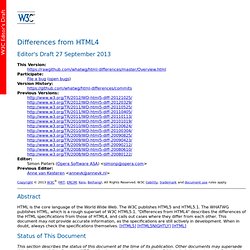
The W3C publishes HTML5 and HTML5.1. The WHATWG publishes HTML, which is a rough superset of W3C HTML5.1. "Differences from HTML4" describes the differences of the HTML specifications from those of HTML4, and calls out cases where they differ from each other. This document may not provide accurate information, as the specifications are still actively in development. HTML 5.1 Nightly. This section describes the status of this document at the time of its publication.
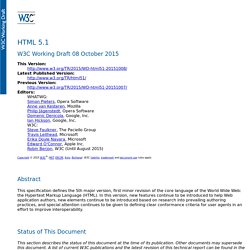
Other documents may supersede this document. A list of current W3C publications and the latest revision of this technical report can be found in the W3C technical reports index at The management and production of this document follows a relatively complex setup. Details are provided as part of the introduction. This document was published by the HTML Working Group as a Working Draft. Publication as a Working Draft does not imply endorsement by the W3C Membership. This document was produced by a group operating under the 5 February 2004 W3C Patent Policy.
The HTML5 test - How well does your browser support HTML5? HTML5 Rocks - A resource for open web HTML5 developers.